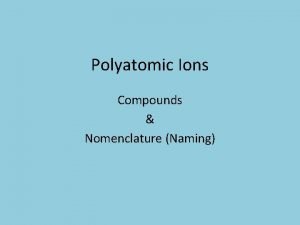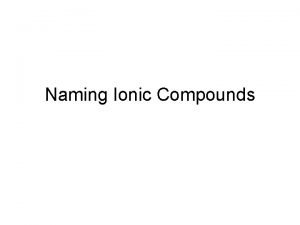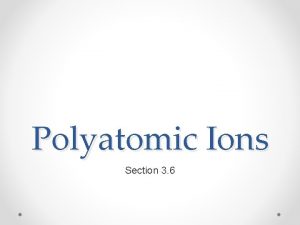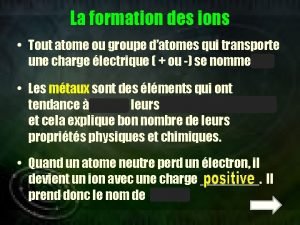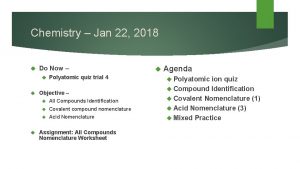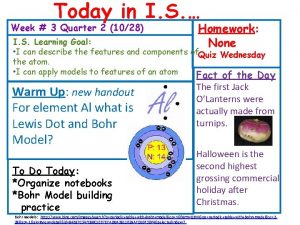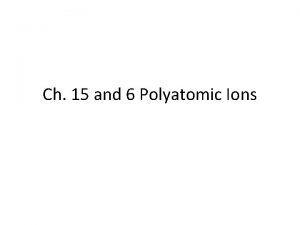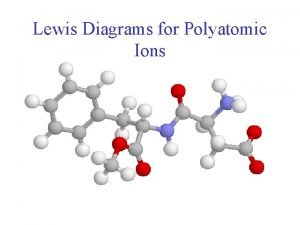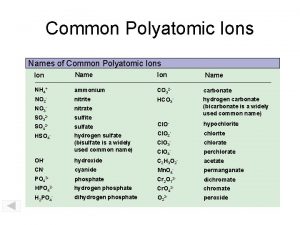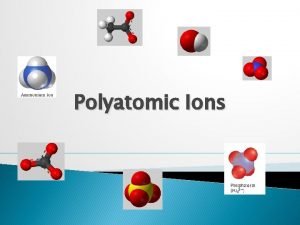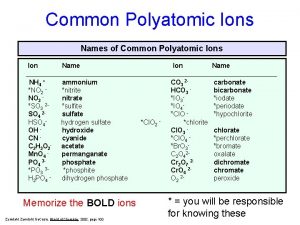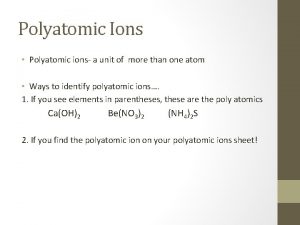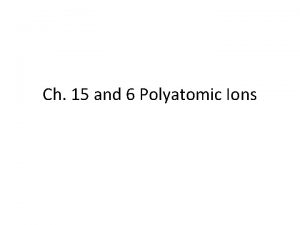Polyatomic Ions Transition Metals Polyatomic Ions are atoms














- Slides: 14

Polyatomic Ions & Transition Metals

Polyatomic Ions are atoms that combine and react as a group. The Charge applies to the ENTIRE GROUP. MEMORIZE THESE!!! 1. Ammonium: NH 4+ 2. Hydroxide: OH 3. Nitrate: NO 3 - 4. Sulfate: SO 425. Carbonate: CO 326. Phosphate: PO 43 - DON’T EVER CHANGE THE SUBSCRIPT!!!

Ohana means family. Family means no one gets left behind - Stitch ( ) Sulfate: 2 (SO 4)

Bonding Rules for Polyatomics 1. Balance the charges between ions (like before) 2. The entire group acts like one ion -Use parentheses if you need more than 1 polyatomic ion (Don’t Change Subscript!): Ex: 2 NO 3 = (NO 3)2 Try: 3 CO 3 = _____ 2 PO 4 = _____

1+ Na with CO 3 2 - Na 2 CO 3

3+ Al with SO 4 2 - Al 2(SO 4)3

NH 4 with CO 3 + 2 - (NH 4)2 CO 3

Polyatomic Ions Practice (Remember: The entire group acts like one ion) n Practice: u. K+ + OH- KOH u. Na+ + SO 4 -2 Na 2 SO 4 u. Ca+2 + OH- Ca(OH)2 potassium hydroxide sodium sulfate calcium hydroxide

Summary: �How do you bond a polyatomic ion? Why are parentheses important?

1. Transition Metals n Transition (are weird!) metals can take on different charges n Roman numerals represent the charge: Fe+2 Fe+3 Iron(II) Iron(III)

Naming Transition Metals Naming Rules for Transition Metals: 1. Separate the ions 2. Figure out the anion 3. Figure out the charge of the cation n Example: u. Fe. Cl 2 Fe 2 Cl. Name: iron (II) chloride Roman Numerals: I, III, IV, V, VII

Practice! n Cu. Cl 2

Practice! n Cu. Cl 2 n Fe. Cl 3 n Pb. O

Writing Formulas from Names n Example: Copper (II) oxide Practice: u. Iron (II) bromide u. Mercury (I) chloride
 Periodic table regents
Periodic table regents List of multivalent metals
List of multivalent metals Mikael ferm
Mikael ferm Criss cross method definition
Criss cross method definition Polyatomic ion
Polyatomic ion Binary compound vs polyatomic ion
Binary compound vs polyatomic ion Ionic compounds list
Ionic compounds list Ionic compounds
Ionic compounds Ionic compounds containing polyatomic ions
Ionic compounds containing polyatomic ions 6 polyatomic ions
6 polyatomic ions Cation polyatomic ions
Cation polyatomic ions Common polyatomic ions quiz
Common polyatomic ions quiz Nick the camel ate clam for supper in phoenix
Nick the camel ate clam for supper in phoenix Polyatomic ions
Polyatomic ions Polyatomic ions
Polyatomic ions




